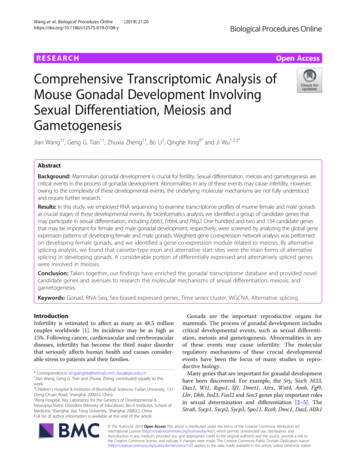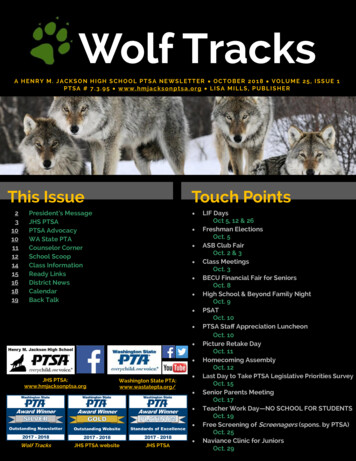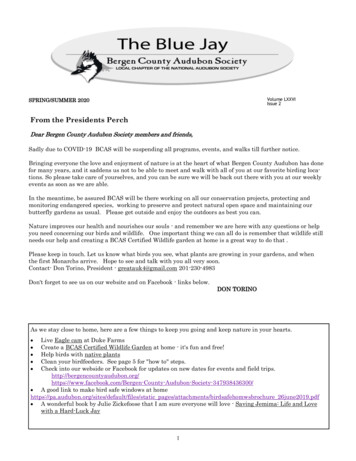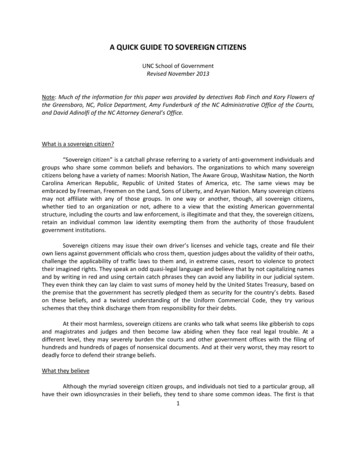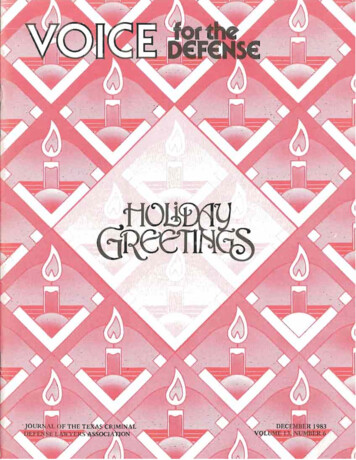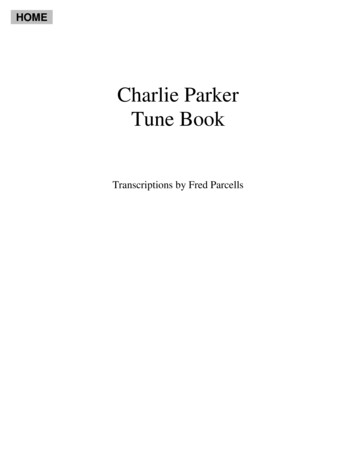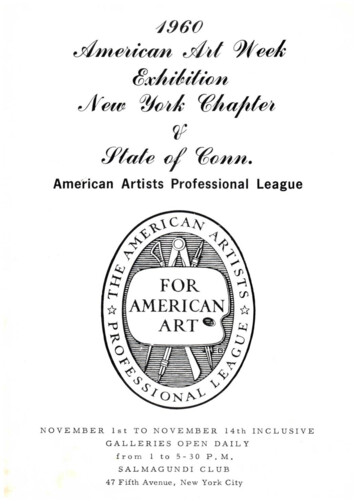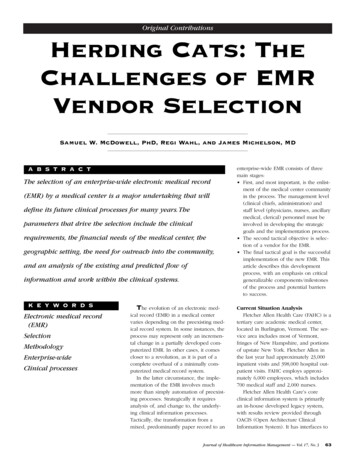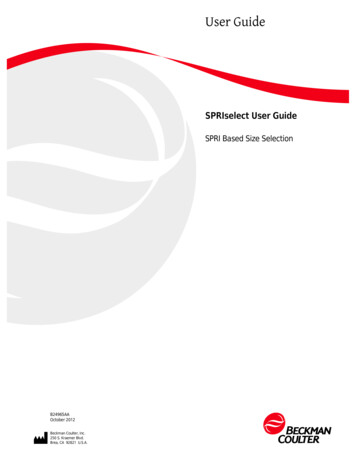
Transcription
User GuideSPRIselect User GuideSPRI Based Size SelectionB24965AAOctober 2012Beckman Coulter, Inc.250 S. Kraemer Blvd.Brea, CA 92821 U.S.A.
SPRIselect User GuidePN B24965AA (October 2012) 2012 Beckman Coulter, Inc.All rights reservedThe Beckman Coulter stylized logo, SPRI and SPRIselectare trademarks of Beckman Coulter, Inc. and areregistered in the USPTO.All other trademarks, service marks, products, or servicesare trademarks or registered trademarks of theirrespective holders.Find us on the World Wide Web at:www.beckmancoulter.comMade in U.S.A.
Revision HistoryInitial Issue, 10/2012SPRIselect User Guide version B24965AAB24965AAiii
Revision HistoryivB24965AA
Safety NoticeDo not attempt to perform any procedure before carefully reading all instructions. Always followproduct labeling and manufacturer’s recommendations. If in doubt as to how to proceed in anysituation, contact your Beckman Coulter Representative.Alerts for Warning, Caution, Important, and NoteWARNINGThe signal word WARNING is displayed in an orange signal panel and the associated text (in thisexample the definition of WARNING) is in bold-face.WARNINGWARNING indicates a potentially hazardous situation which, if not avoided, couldresult in death or serious injury.In this document the signal word WARNING is only used to indicate the possibility of personalinjury. It is not used to indicate the possibility of erroneous data.CAUTIONThe signal word CAUTION is displayed in a yellow signal panel and the associated text (in thisexample the definition of CAUTION is in bold-face as shown below.CAUTIONCAUTION indicates a potentially hazardous situation, which, if not avoided, mayresult in minor or moderate injury. It may also be used to alert against unsafepractices.In this document the signal word CAUTION is used to indicate the possibility of damage to theinstrument.IMPORTANTThe signal word IMPORTANT is in bold-face and the associated text (in this example the definItionof IMPORTANT) is indented if it wraps.IMPORTANT IMPORTANT is used for comments that add value to the step or procedure being performed.Following the advice in the Important adds benefit to the performance of a piece of equipment or to aprocess.The signal word IMPORTANT is used to draw attention to information that is critical for thesuccessful completion of a procedure and/or operation of the instrument.B24965AAv
Safety NoticeAlerts for Warning, Caution, Important, and NoteNOTEThe signal word NOTE is in bold-face and associated text (in this example the definition of NOTE) isindented if it wraps.NOTE NOTE is used to call attention to notable information that should be followed during installation, use,or servicing of this equipment.viB24965AA
ContentsRevision History, iiiSafety Notice, vAlerts for Warning, Caution, Important, and Note, vWARNING, vCAUTION, vIMPORTANT, vNOTE, viIntroduction, ixIntroduction to the SPRIselect User Guide, ixAbout This Manual, ixIntended Use, ixWarranty Disclaimer, ixConventions Used, ixSPRI Based Size Selection, 1Introduction, 1Materials, 1Sample Prerequisites, 2Left Side Size Selection, 3Right Side Size Selection, 5Double Size Selection Considerations, 8Effects of Common Laboratory Reagents on Size Selection, 10Indexvii
Contentsviii
IntroductionIntroduction to the SPRIselect User GuideAbout This ManualThe information in this manual is organized as follows:SPRI Based Size SelectionProvides an overview of SPRIselect, its uses and its key features.GlossaryProvides definitions for terms used throughout this manual.Intended UseSPRIselect is intended for molecular biology research applications. It is not intended or validatedfor use in the diagnosis of disease or other conditions.Warranty DisclaimerBeckman Coulter makes no warranties of any kind whatsoever express or implied, with respect tothe method, including but not limited to warranties of fitness for a particular purpose ormerchantability or that the method is non-infringing. All other warranties are expresslydisclaimed. Your use of the method is solely at your own risk, without recourse to Beckman Coulter.Conventions UsedThis manual uses the following conventions: The names of instrument manuals referred to in the text are in italic. Messages that appear on the instrument screen are in italic. Buttons that appear on the instrument screen are in bold face. Selections that appear on the instrument screen are in bold face. The software path to a specific function or screen appears with the greater than ( ) symbolbetween succeeding screen options, like this: Options Log Configuration.B24965AAix
IntroductionIntroduction to the SPRIselect User GuidexB24965AA
SPRI Based Size SelectionIntroductionSPRIselect is a SPRI-based chemistry that speeds and simplifies nucleic acid size selection forfragment library preparation for Next Generation sequencing. In this process, size selection isrequired to produce a uniform distribution of fragments around an average size. Using SPRIselect,the size distribution can be adjusted to suit the application and platform used. The process can bescaled for low to high throughput workflows.The guidance provided below can be used to optimize the desired size selection range. Usedmanually or automated on a liquid handling system such as the Biomek Laboratory AutomationWorkstation, SPRIselect will provide rapid and consistent size selection suitable for mostapplications.SPRIselect is covered by US Patents 5705628, 6534262, and 5898071.Materials 85% Ethanol, non-denatured (ethanol is hygroscopic, prepare fresh for optimal results) Water (molecular biology grade) or a standard buffer solution such as Tris (10 mM, pH 8) or TE(10 mM Tris, pH 8, 1 mM EDTA) for DNA elutionB24965AA1-1
SPRI Based Size SelectionSample PrerequisitesSample Prerequisites Samples should be fragmented double-stranded DNA. Samples should be dissolved in molecular biology grade water or standard buffer solution suchas Tris or TE. See Effects of Common Laboratory Reagents on Size Selection at end of user guide formore information. Sample volume should be 50 μL. A lower volume will decrease pipetting accuracy ofSPRIselect, therefore increasing selection point variability. DNA fragments may be size selected in a range no smaller than 150 bp and no larger than 800 bp. To maximize recovery for a Left Side Size Selection, the majority of the sample’s sizedistribution should be larger than the selection point. To maximize recovery for a Right Side Size Selection, the majority of the sample’s sizedistribution should be smaller than the selection point. To maximize recovery for a Double Size Selection, the size distribution should be centeredbetween the selection points.1-2B24965AA
SPRI Based Size SelectionLeft Side Size SelectionLeft Side Size SelectionAs a general rule, increasing the ratio of SPRIselect volume to sample volume will increase theefficiency of binding smaller fragments. Figure 1 illustrates this relationship.Figure 1 Agilent High Sensitivity DNA chip Electropherogram.M upper and lower markers for High Sensitivity DNA chipShear 1 μL of 20 ng/μL input control sample in water1.2x to 0.4x 1 μL of shear, size selected with given ratio of SPRIselect volume to samplevolume.Figure 21. Thoroughly shake the SPRIselect bottle to resuspend the SPRI beads. Following the trenddepicted in Figure 1, add the required volume of SPRIselect for the desired ratio to the sample.TIP Volume of sample * ratio volume of SPRIselect.Example: 50 μL sample * 0.8x ratio 40 μL of SPRIselect2. Mix the total reaction volume by pipetting 10 times and incubate at RT for 1 minuteORB24965AA1-3
SPRI Based Size SelectionLeft Side Size Selectionvortex for 1 minute at an appropriate speed until homogenous (depending on labware and totalvolume).NOTE Insufficient mixing of sample and SPRIselect will lead to inconsistent size selection results. Makesure to mix well.3. Place the reaction vessel on an appropriate magnetic stand or plate and allow the SPRI beads tosettle to the magnet. Settle times will vary; a higher initial sample volume, higher SPRIselectratio or weaker magnets will require a longer settle time. Remove and discard the clearsupernatant.NOTE Care should be taken not to aspirate more than a trace amount of beads during this step, as thedesired library is associated with the beads. Significant bead loss will result in reduced yield.4. With the reaction vessel still on the magnet, add 180 μL of 85% ethanol (non-denatured) andincubate at RT for 30 seconds. Remove and discard the ethanol supernatant.NOTE Care should be taken not to aspirate more than a trace amount of beads during this step, as thedesired library is associated with the beads. Significant bead loss will result in reduced yield.5. To elute the sample:a.Remove the reaction vessel from the magnet and add 20 μL of molecular biology gradewater or standard buffer solution such as Tris or TE.NOTE Elution volume should be large enough so that the liquid level is high enough for the beadsto settle to the magnet.b. Mix the total elution volume by pipetting 10 times to resuspend the beads and incubate atRT for 1 minuteORvortex for 1 minute at an appropriate speed until homogenous (depending on labware andtotal volume).c. Place the reaction vessel on an appropriate magnetic stand or plate and allow the SPRIbeads to settle to the magnet. Settle times will vary; a higher elution volume or weakermagnets will require a longer settle time.6. Transfer the eluate (size selected sample) to an appropriate storage vessel.1-4B24965AA
SPRI Based Size SelectionRight Side Size SelectionRight Side Size SelectionAs a general rule, increasing the ratio of SPRIselect volume to sample volume will decrease theefficiency of binding larger fragments. Figure 3 illustrates this relationship.Figure 3 Agilent High Sensitivity DNA chip Electropherogram.M upper and lower markers for High Sensitivity DNA chip.Shear 1 μL of 20 ng/μL input control sample in water.1.2x to 0.4x 1 μL of shear, size selected with given ratio of SPRIselect volume to samplevolume.Figure 41. Thoroughly shake the SPRIselect bottle to resuspend the SPRI beads. Following the trenddepicted in Figure 3, add the required volume of SPRIselect for the desired ratio to the sample.TIP Volume of sample * ratio volume of SPRIselect.Example: 50 μL * 0.7x ratio 35 μL of SPRIselect2. Mix the total reaction volume by pipetting 10 times and incubate at RT for 1 minuteORB24965AA1-5
SPRI Based Size SelectionRight Side Size SelectionVortex for 1 minute at an appropriate speed until homogenous (depending on labware and totalvolume).NOTE Insufficient mixing of sample and SPRIselect will lead to inconsistent size selection results. Makesure to mix well.3. Place the reaction vessel on an appropriate magnetic stand or plate and allow the SPRI beads tosettle to the magnet. Settle times will vary; a higher initial sample volume, higher SPRIselectratio or weaker magnets will require a longer settle time.4. Transfer the clear supernatant, which contains the Right Side Size Selected sample, to a newreaction vessel. The reaction vessel with the remaining beads can be discarded.NOTE Care should be taken not to aspirate more than a trace amount of beads during this step as theundesired larger fragment sizes are associated with the beads. Significant bead transfer will causetailing into the larger size range.5. Add the required volume of SPRIselect, using the calculation below, to the supernatant fromStep 4 above. This will bind the fragments in the supernatant to the new SPRI beads.TIP Sample Volume μL * (1.8x – the initial ratio) volume of SPRIselectExample: 50 μL * (1.8 – 0.7) 55 μL of SPRIselect6. Perform the following:a. Mix the total reaction volume by pipetting 10 times and incubate at RT for 1 minuteORvortex for 1 minute at an appropriate speed until homogenous (depending on labware andtotal volume).NOTE Insufficient mixing of sample and SPRIselect will lead to inconsistent size selection results.b. Place the reaction vessel on an appropriate magnetic stand or plate and allow the SPRIbeads to settle to the magnet. Settle times will vary; a higher initial sample volume, higherSPRIselect ratio or weaker magnets will require a longer settle time.c. Remove and discard the clear supernatant.NOTE Care should be taken not to aspirate more than a trace amount of beads during this step, as thedesired library is associated with the beads. Significant bead loss will result in reduced yield.7. With the reaction vessel still on the magnet, add 180 μL of 85% ethanol (non-denatured) andincubate at RT for 30 seconds. Remove and discard the ethanol supernatant.NOTE Care should be taken not to aspirate more than a trace amount of beads during this step, as thedesired library is associated with the beads. Significant bead loss will result in reduced yield.8. To elute the sample:a. Remove the reaction vessel from the magnet and add 20 μL of molecular biology gradewater or standard buffer solution such as Tris or TE.NOTE Elution volume should be large enough so that the liquid level is high enough for the beadsto settle to the magnet.1-6B24965AA
SPRI Based Size SelectionRight Side Size Selectionb. Mix the total elution volume by pipetting 10 times to resuspend the beads and incubate atRT for 1 minuteORvortex for 1 minute at an appropriate speed until homogenous (depending on labware andtotal volume).c. Place the reaction vessel on an appropriate magnetic stand or plate and allow the SPRIbeads to settle to the magnet. Settle times will vary; a higher elution volume or weakermagnets will require a longer settle time.9. Transfer the eluate (size selected sample) to an appropriate storage vessel.B24965AA1-7
SPRI Based Size SelectionDouble Size Selection ConsiderationsDouble Size Selection ConsiderationsAs a general rule, the Left Side Size Selection ratio always needs to be greater than the Right SideSize Selection ratio. Figure 5 illustrates this relationship.Figure 5 Agilent High Sensitivity DNA chip Electropherogram.M upper and lower markers for High Sensitivity DNA chipShear 1 μL of 20 ng/μL input control sample in water0.XX to 0.XX 1 μL of shear, size selected with given Left side ratio and Right side ratio ofSPRIselect volume to sample volumeTable 1 Typical Recovery (determined by experiment)Percentages calculated from Agilent 2100 Expert Smear Region analysis Conc. [pg/μL]Table 1 Definitions:Ratios (Left-Right): Left Side Size Selection ratio - Right Side Size Selection ratiobp Region: Agilent 2100 Expert Smear Region analyzed for the given Ratios (Left-Right)Selection Delta (bp): The difference between the Left and Right selection points of the bp RegionExample: 660 Right bp – 230 Left bp 430 bp Delta1-8B24965AA
SPRI Based Size SelectionDouble Size Selection ConsiderationsTable 2 Recovery of Shear- Note: the 0.8-0.61 ratio sample seen in Table 1 will be used for all definitionexamples belowDefinitionB24965AAbp Region’s% of ShearThemaximumpotentialrecovery ofthe Stocksample forthe targetedsize selectionregion.Recovered %of bp RegionPercentrecovery ofthe targetedregionRecovered %of ShearPercentrecovery ofthe Shearsample.Diagram1-9
SPRI Based Size SelectionEffects of Common Laboratory Reagents on Size SelectionEffects of Common Laboratory Reagents on Size SelectionThe common laboratory reagents described in Table 3 were added to the reaction (as an additive)to determine the effect on Size Selection. Each Left Side Size Selection below was 1 μg sheared in 50 μL 50 μL additive 65 μL SPRIselect(0.65x ratio). Final elution in 100 μL of water. 1 μL of eluent was run on an Agilent HighSensitivity DNA chip.TIP If a possible reagent additive not listed below is of concern, use this dilution scheme to test if thereis any effect on size selection. The “0.65x Control” (red trace) is the expected selection result for a 0.65x Left Side SizeSelection. The concentration of the additive can be found in the Electropherogram table. The “M” is the Agilent High Sensitivity DNA assay’s upper and lower markers. Keep in mind that additive effects are cumulative. If there are multiple additives that all movethe selection the same direction, the result will be larger than any individual component. Ifsome component(s) move the selection Left and some Right, it’s possible to have little to noeffect.1-10B24965AA
SPRI Based Size SelectionEffects of Common Laboratory Reagents on Size SelectionTable 3 Effects of Common Laboratory Reagents on Size Selection. Blue background represents widerselection. Red background represents narrower xide)NoneDTT(Dithiothreitol)None85% EthanolWider SizeSelectionAgilent High Sensitivity Chip Trace1-11
SPRI Based Size SelectionEffects of Common Laboratory Reagents on Size SelectionTable 3 Effects of Common Laboratory Reagents on Size Selection. Blue background represents widerselection. Red background represents narrower selection.1-12AdditiveEffectGlycerolNarrower siumchloride)Wider SizeSelectionAgilent High Sensitivity Chip TraceB24965AA
SPRI Based Size SelectionEffects of Common Laboratory Reagents on Size SelectionTable 3 Effects of Common Laboratory Reagents on Size Selection. Blue background represents widerselection. Red background represents narrower e)NonePEG(Polyethyleneglycol)Wider SizeSelectionAgilent High Sensitivity Chip Trace1-13
SPRI Based Size SelectionEffects of Common Laboratory Reagents on Size SelectionTable 3 Effects of Common Laboratory Reagents on Size Selection. Blue background represents widerselection. Red background represents narrower selection.1-14AdditiveEffectpHNarrower SizeSelection forpH 3.No effect forpH 3.Sodium AcetateNoneAgilent High Sensitivity Chip TraceB24965AA
GlossaryGlossaryB24965AAbpbase pairDouble Size Selectiona Left and Right Side Size Selection performed on thesame sampleLeft Side Size Selectiondefines the new start point of the sample’s ograms per microliterRight Side Size Selectiondefines the new end point of the sample’s sizedistributionRTRoom Temperature (15-30 C)Tristris(hydroxymethyl)aminomethane (10 mM, pH 8)TETris with Ethylenediaminetetraacetic acid(10 mM Tris, pH 8,1 mM EDTA)Glossary-1
GlossaryGlossary-2B24965AA
IndexCconcentration of the additive, 1-10HHigh Sensitivity DNA chip, 1-5Double Size Selection, 1-8Left Side Size Selection, 1-3LLeft and Right Side Size Selectionmaximize recovery, 1-2Left Side Size Selectionmaximize recovery, 1-2Mmaximize recoveryLeft and Right Side Size Selection, 1-2Left Side Size Selection, 1-2Right Side Size Selection, 1-2RRight Side Size Selectionmaximize recovery, 1-2SSample Prerequisites, 1-2Sample volume, 1-2standard buffer solution, 1-2Ttrademarks, i-iiIndex-1
IndexIndex-2
www.beckmancoulter.com 2012 Beckman Coulter, Inc.All Rights Reserved
B24965AA 1-3 SPRI Based Size Selection Left Side Size Selection Left Side Size Selection As a general rule, increasing the ratio of SPRIselect volume to sample volume will increase the efficiency of binding smaller fragments.
